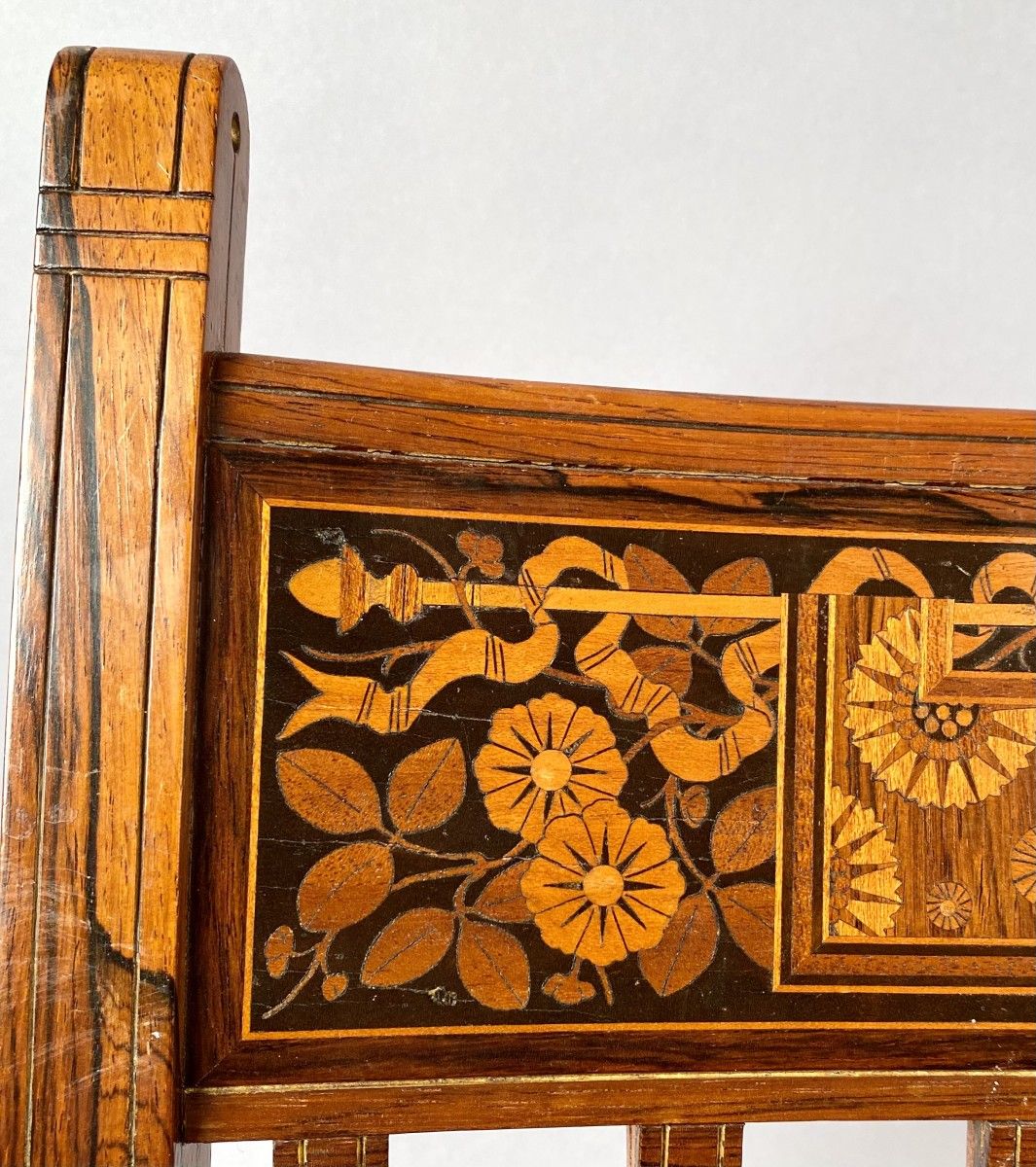
A Wonderful Chair
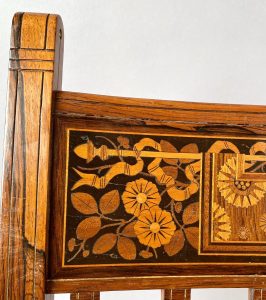
Every so often, I am reminded of the reason that I do what I do. As a child I loved finding interesting and unusual things, I collected them to the point that my mother gave up attempting to manage or have me manage my bedroom – a wonderful (to me) and messy (to my mother) array of toys, coins, stamps, shells, mineral specimens, sports cards, posters, football stickers off of Chichita bananas, baseballs, autographs, and anything and everything else that caught my eye and could be put in my pocket (or not) and carried home. This included anything that also might be sold or traded for a little money or for something even more interesting or valuable.
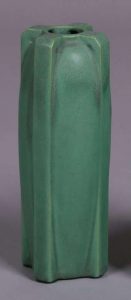
As I grew into adulthood the objects of my interest and passions changed, evolving and shifting as I did. I bought batiks from a factory in Sumatra, dug 300+ bottles from an old Victorian house dumping ground in Saratoga Springs with my friend Denny, scoured antique shops for good buys, started going to small country auctions buying box lots to resell at a barn sale on the weekend with my girlfriend (eventually my wife). The occasional unexpected reward (like a beautiful Teco matte green buttressed small American art pottery vase in a $5 box lot – sold for $300), fueled my forward momentum.
My methods evolved also, although the wonderful (to me) and disorderly (to my wife) crazy and random array (that I still maintain) in my home, office, car, shop, or warehouse continued and grew even. I went to auctions and garage sales for fun, started selling things at auction or running my own little sales. Bemused by the nuts and bolts of academic research and intimidated by the prospect of my PhD oral examinations in Materials Engineering, I left grad school and launched into full time “Antique Dealing”. I started advertising to buy antiques and began setting up and selling as a vendor at antique shows.
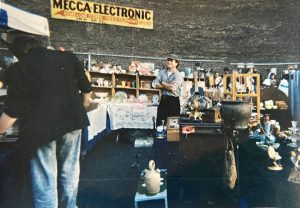
This included several years at the outdoor 26th street flea market on 6th Avenue in Manhattan, where I was brutally schooled in basic hardball negotiation as practiced by every culture on earth: Armenian, Persian, Indian, Russian, Chinese; it was tough as nails there. There is nothing quite like the classist contempt of a professional English antiques dealer trying to purchase something at a better price or the relentless and stubborn assault of the Chinese dealer. I learned quickly the value of simply walking away in a pinch. The long term vendors were weathered and leathery in countenance and manner – but loyal and true (to a point) once they got to know you.
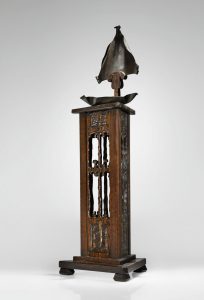
There were regularly great finds made there on 26th street, usually during the mad rush of unpacking and setting up in the dark at 4:00am while the pros, away from their galleries on Madison Avenue, hurried from vendor to vendor with their flashlights searching in the darkness looking for the next best great find. I remember the discovery of an important carved Charles Rohlfs Arts & Crafts fumed oak stand, purchased for $250 and worth $5,000 plus. (pic) I would find interesting things for a good price occasionally myself that I could bring back to upstate New York – it was a fun and exciting place – beautiful things and beautiful people, regular celebrity sightings, a colorful and ever changing array of life and art.
Today I meet with clients at one of my offices or go on house calls to help families with estates when they are ready to make decisions about where things can go. I never know what I am going to see when I walk in the door or what will be revealed in the attic or basement of an impressive or modest home. I was delighted recently by a remarkable chair from a small estate in Albany, New York that I wanted to talk about.
The most prominent American furniture maker of the late 19th century was the firm of Gustave and Christian Herter, Herter Brothers. From their founding in 1861 until 1908 they manufactured some of the finest and most exquisitely designed and crafted furniture in the United States. Clients included J.P. Morgan, the Vanderbilts, Jay Gould and the White House under Ulysses S. Grant and Theodore Roosevelt. They were the first company in the US that offered complete interior decorating services including the design and construction of each room and furnishings in a home. I went on a call 15-20 years ago to look at an upright piano (normally the last thing on earth an antique dealer will travel to look at – difficult to move, nearly impossible to sell) because it was a slow day and the caller said it had lots of inlay work. That piano turned out to be a Herter Bros cased Weber piano that had been made for and exhibited at the 1876 Philadelphia Exposition. The exquisite example of cabinet making and case work more than justified the $500 to have it professionally brought out of the basement where it lived.
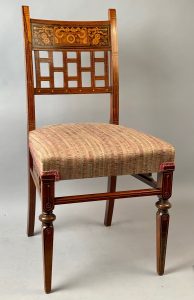

Imagine my surprise and delight when I came across this chair (pic) among the contents of a small apartment in Albany, where I had been called by a family to help clear the contents belonging to their late mother. Crafted from solid rosewood with incised and gilded detailing and cut outs, the side chair had an ornate Japonesque inlay marquetry back splat immediately recognizable as Herter. It did not take long to confirm this attribution (there was actually a clipping with the chair detailing a matching example for sale – “price on request”) and learn that the chair was part of the furnishings created for the Mark Hopkins house on Nob Hill in San Francisco in 1878. More exciting yet – the chair had an original pencil notation on the inside seat rail of the chair beneath the upholstery “Mr. Hopkins”.
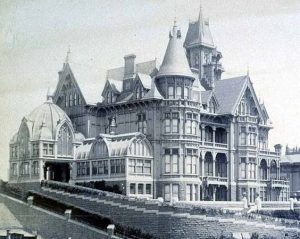
Mark Hopkins Jr. was one of the founders of the Union Pacific Railroad, unfortunately he died just before the completion of the mansion on Nob Hill that he was building for his wife Mary. Mary hired Herter Brothers to complete the furnishings and interiors of the house. A full service firm 😉 , they sent one of their employees Edward Searles to supervise the job – the job was truly completed when he and Mary married in 1887. The story does not stop there, and what a story it is! Has anyone done a movie about this? Check out Wikipedia, there is more than enough juicy material for a multi season mini-series on Netflix. The house survived the 1906 San Francisco earthquake, only to be consumed by the fires that raged in the earthquake’s aftermath.
Who knows how this chair and others matching it survived, I often wonder at the stories antique objects might tell. A connoisseur can deduce some of that history from the unaltered and unrestored wear and patination that a piece bears, but what happened around each object over decades or centuries is lost to all but our imaginations; a hurried scramble away from a encroaching blazing inferno then decades in a dark and quiet room, joyous Christmases celebrated or support for a heartbreaking loss and disappointment born in solitude. Our imaginations are always ready to attend the silent and empty history, thankfully today the imagin-ings of Gustave and Christian Herter survive to tell a bit of their and their clients stories.
This Herter Brothers incised and gilded rosewood, marquetry inlay chair from the Mark Hopkins house will be featured in our upcoming (it’s Spring, thank goodness!) Live Auction of Decorative Arts, Fine Antique Silver, Estate Jewelry & Rare Collectibles. Catalog bidding begins Friday March 6th through Saturday March 27th, when the live auction begins at 12:00pm noon EST.
